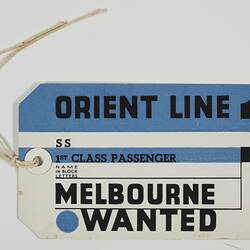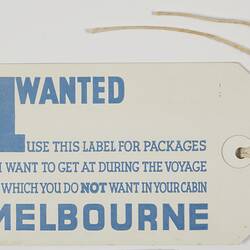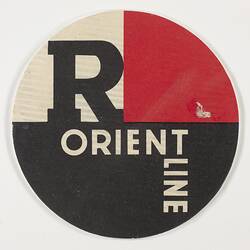Summary
Alternative Name(s): Luggage Tag.
Rectangular white and blue baggage label intended for use by first-class passengers on the Orient Line Royal Mail Steamship services between England and Australia, for identification of baggage wanted on the voyage but not to be placed in the cabin.
The Orient Steam Navigation Company was founded by Anderson, Anderson & Co, of London, in 1877 commencing passenger and cargo steamship services between England and Australia using initially chartered steamers, and later its own vessels purchased in conjunction with Pacific Steam Navigation Co. Within a few years the Orient Line had won a share of the lucrative mail contracts and premium passenger trade from the established P&O Line and the two companies continued to share regular scheduled services via the Suez Canal for many decades. In 1906 Pacific Steam Navigation Co. was acquired by Royal Mail Steam Packet Co. and the Australian service became known as the Orient-Royal Mail Line, but this arrangement terminated in 1909, reverting to the Orient Line name. In 1919 P&O Line acquired a controlling interest in the Orient Line. In 1938 the Australian service was extended to New Zealand. In 1965 P&O acquired the whole of the remaining Orient Line shareholdings and the company became a P&O subsidiary. After operating for about a decade as the P&O Orient Lines, the Orient name was eventually dropped and subsequently disappeared from use.
In contrast to the P&O Line which offered full first, second and third class services, Orient Line ships offered only first and third class services (with the latter known as 'Tourist Class' from the 1920s onwards). Orient Line ships typically were routed via the Suez Canal on both the outward and homeward voyages, with typical stopovers on route being Gibraltar, Toulon, Naples, Port Said, Aden and Colombo.
Physical Description
Rectangular card white and blue baggage label. White string attached to label.
More Information
-
Collecting Areas
-
Acquisition Information
Purchase
-
Place Used
-
Inscriptions
Obverse; 'ORIENT LINE / SS / 1ST CLASS PASSENGER / NAME / IN BLOCK / LETTERS / MELBOURNE / WANTED'. Text at right side of label '1'.
-
Brand Names
-
Classification
-
Category
-
Discipline
-
Type of item
-
Overall Dimensions
140 mm (Width), 82 mm (Height)
Excludes 120 mm long double tie string attached to left-hand end.
-
Keywords
Baggage Labels, Immigrant Shipping, Passenger Ships, Shipping Companies, Shipping Lines



